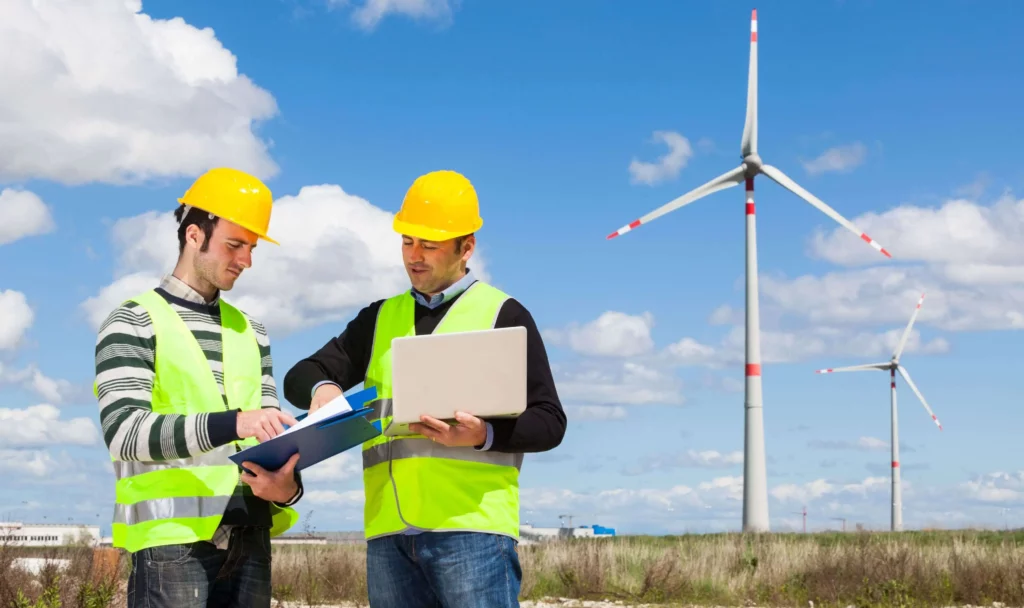Introduction
The energy transition towards renewable energy, especially wind energy, is quickly gaining momentum across the world. Due to this very fact, blade inspections are becoming critical maintenance operations for the wind industry. Though numerous inspection techniques already exist, the introduction of advanced technology has shown noble promises.
 Drone Technology in Wind Turbine Inspection
Drone Technology in Wind Turbine Inspection
The inception of Drone Technology in the commercial domain has revolutionized industries and their data acquisition techniques. The wind industry has favorably employed UAVs on-site for magnified monitoring and surveillance. Drones coupled with AI and Machine Learning, present functional and remarkably reliable solutions for probing wind turbines and its associated infrastructure. When opposed to traditional inspection methods in renewable energy, drones promote safety by withdrawing workers from dangerous situations on-site, decrease maintenance costs, inspection costs, and even minimize downtime.
Benefits of Wind Turbine Drone Inspection
Detailed Data :
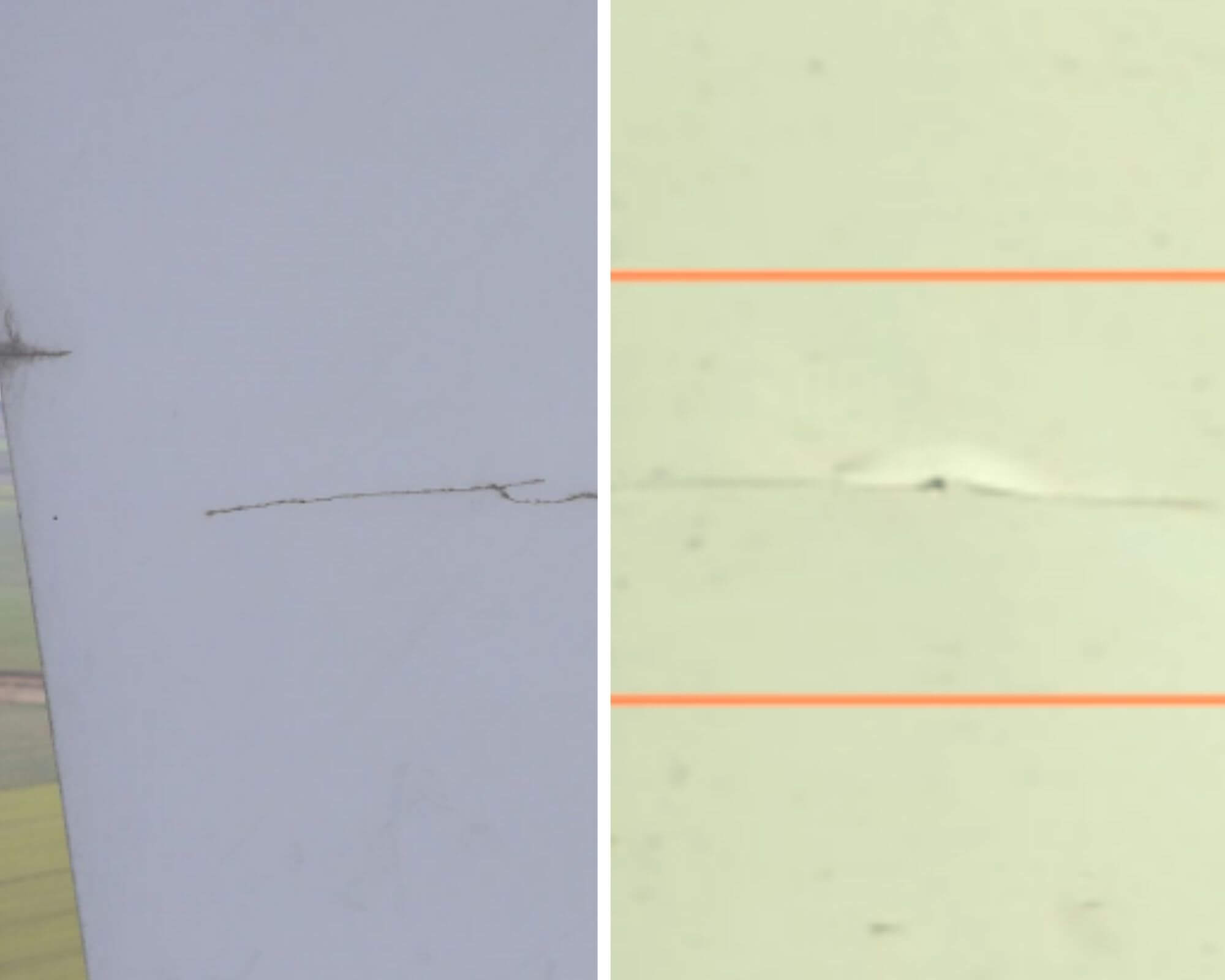
Horizontal Crack Drone data is known to be clear, precise, and of high-resolution. UAVs furnished with high-quality cameras can precisely seize aerial photographs and videos of the entire blade with clarity upto 40 MP! Backed with advanced technologies such as LiDAR, operators can even obtain explicit measures of defects and other potential hazards. Details procured via modern drone technology are remarkably beneficial for the up-keep of assets and the retainment of their productivity. Simultaneously, the level of precision seized through UAVs is undoubtedly unbeatable against other inspection techniques.
- Drone Data Can Be Analyzed : Once the drone data is achieved, it is passed through diverse automated processing and classification systems. Specialists in the field of information manually scrutinize the data for quality checks and evaluate any significant concerns regarding the wind turbine and its related infrastructure. The data is often represented as 3D models or other prototypes of designs for easy interpretations. The complete process assures that all gaps are recognized and annotated for prompt decision-making and effective asset maintenance.
- Drone Data Is Easy To Use : Once the data is processed, it’s often uploaded on an online portal. The organization can inspect the data to recognize defects and even classify data according to their needs. The data is often accessible on various devices such as phones, laptops, and even tablets. The company is confronted with the utmost convenience as the data report of defects can effortlessly be displayed as a PDF in a button’s touch! The drone data is supplied to clients in such a manner that it becomes notably simple to understand and interpret.
- Data Can Be Organised And Stored : UAV data are arranged and stored so that organizations can appropriate this information in the future as well. For activities such as progress monitoring especially, storing data is a necessity. The information is securely uploaded onto a portal to which only the organization has access. Businesses can keep track of changes and even make comparisons for further analysis in the future.
- Safety & Efficiency : Enhanced workers’ efficiency and safety are probably one of the leading reasons why drones are so popular in the energy industry. Crew members have the opportunity to get a closer look at potential defects instantly without having to indulge in hazardous manual techniques, which would require them to climb wind turbines. With UAVs on-site, last-minute spot checks can be administered in minimal time through aerial photography. Not only is worker-safety being prioritized, wind-turbine downtime is also minimized, all with the retainment of information quality.
You may also like
Inspection Methods
- Surface Inspection : Surface inspection techniques involve visual examinations by workers on-site. Surface visual inspections of wind turbines may be carried out using several procedures:
- Rope-access method (worker is on a foundation hung from a nacelle/elevated platform);
- Utilizing binoculars or telescopes;
- Employing a ground-based or drones with a stabilized camera.
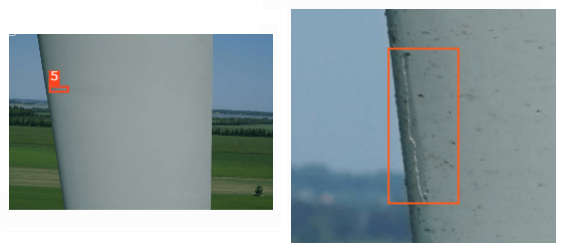
Possible Crack Blade inspections can enhance the adequate discovery of external flaws and hazards on wind turbines. Cracks, erosion, lightning destruction, and adhesive debonding are a few external defects that can be visualized easily using surface inspection procedures. Rope access method would take longer working hours for each blade, resulting in higher costs. In contrast, drone-based inspections would be prompt and more efficient. However, it is essential to note that some surface investigations are ineffectual for recognizing an asset’s internal defects.
- Sub-Surface Inspection : There is a menu of sub-surface inspection methods out there that can recognize defects below the blade’s surface. Few techniques are popular amongst turbine manufacturers, whereas the company employs the others on commissioned turbines. The following are examples of sub-surface inspection methods:
- Acoustic emission (sound and ultrasound)
- Shearography
- Thermography
- Electromagnetism (eddy currents)
- Radiography (X- and gamma rays)
- Visual inspection
Sub-surface inspections are generally said to be non-destructive and are often done on-site, in a laboratory, or a manufacturing unit. The principle accompanying this inspection method requires measuring electromagnetic or acoustic waves (any structural change alters the wavelength). Since these methods are comparatively less refined, they are costlier technologies to adopt in the energy industry.
- Condition Monitoring Systems : Condition-monitoring systems guarantee constant monitoring by utilizing high-quality sensors installed on turbines to recognize any defects. This inspection method cannot be employed to identify the precise position of the damage. However, it is often coupled with other inspection methods mentioned above for effective detection and repairs. The sensors installed in blades detect natural vibration and frequency trends that can identify any damages. This method is expensive as it demands to be installed on every wind turbine.
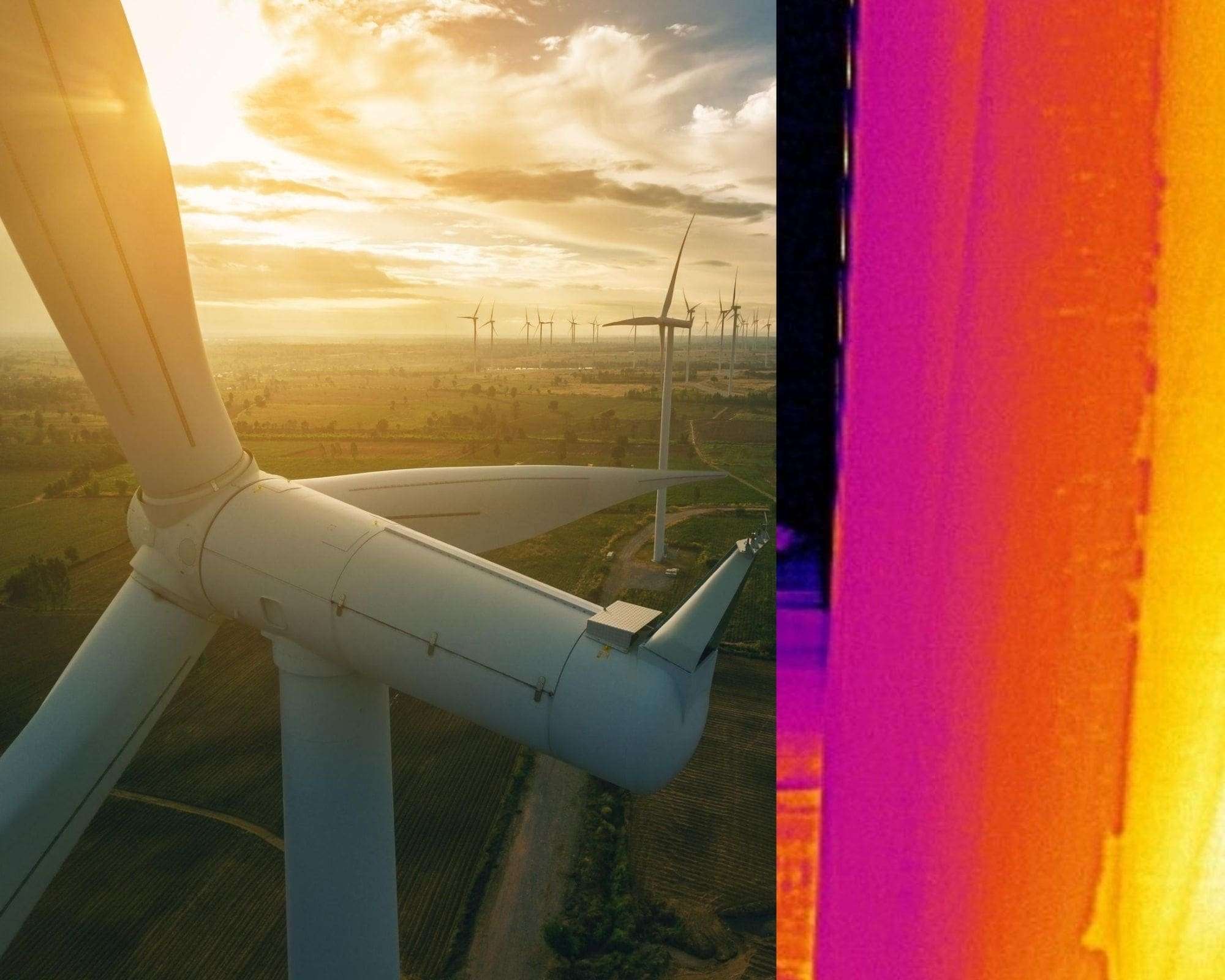
Thermal Image Countless challenges arise by relying on Condition-monitoring systems. Some of them include:
- Should the sensors be installed during the manufacturing processes or after the commissioning of the wind turbine?
- Can your sensors advance their functions efficiently for approximately 20 years or so?
- Is there effective compliance of data transmission, storage, processing, and interpretation in place?
Data Collection
Diverse drone data acquisition techniques are being adopted for wind farms as technology takes over. However, to keep it brief, there are two general classifications; manual and automated.
- Manual Flight : This technique empowers the drone pilot to be in complete control of the unmanned vehicle at all times. Having said this, the drone operator must mirror all skills and experiences demanded to achieve valid and authentic data from the wind farms. Pilots must have the expertise to securely capture uniform and sharp photographs of all components of the blade. If the pictures are seized in a specific structure and frequency, arrangement and processing of data for in-depth analysis becomes more manageable.
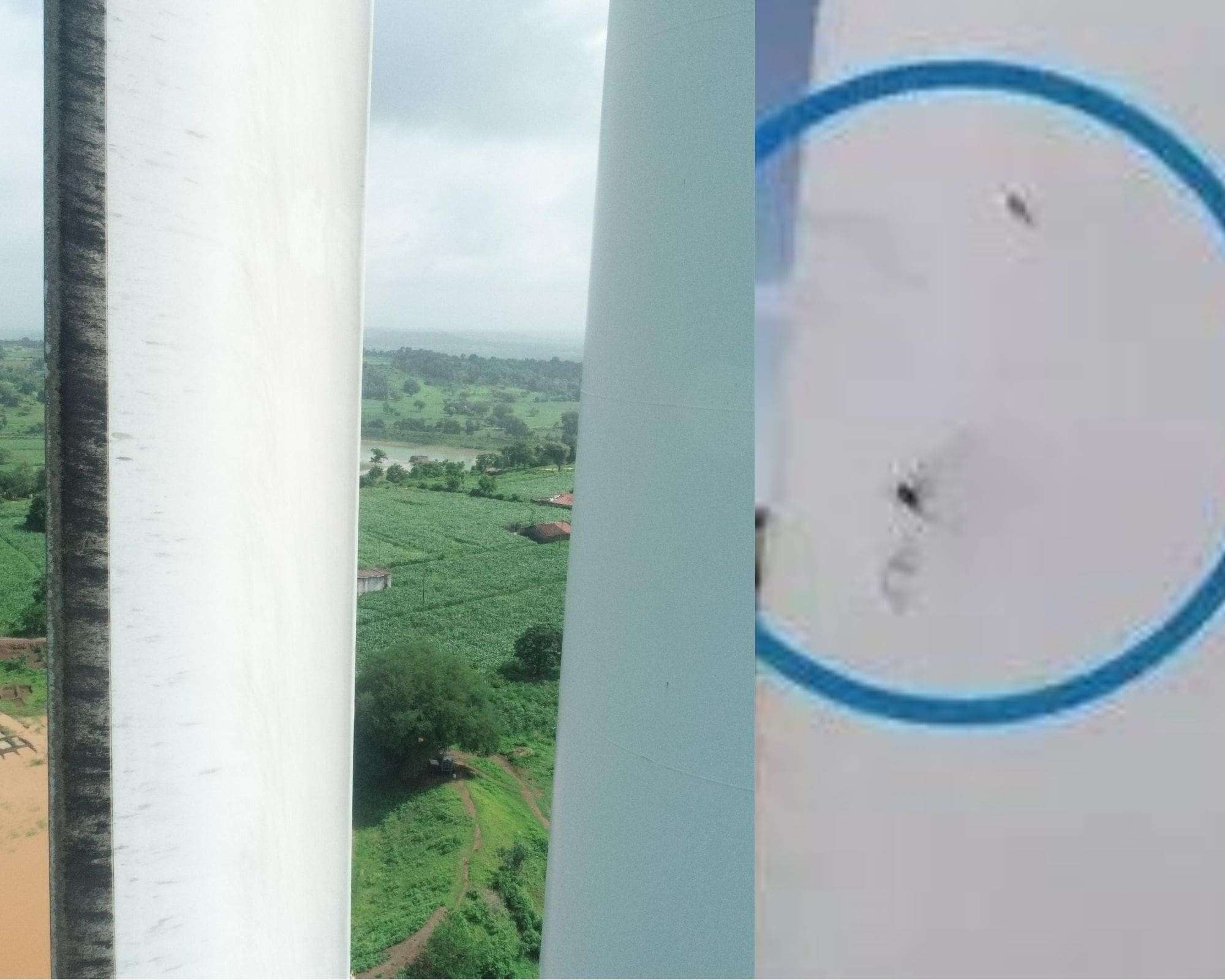
Lighting Receptor This data collection method is suitable for spot checks such as identifying possible lighting damage or even reinforcing a concluded repair on the wind turbine. If wind farms employ manual data collection techniques by adopting UAVs, mainly just for spot checks, the equipment expenses will be more limited. Though you would still require high-quality professional gear furnished with RGB cameras and sensors, cumulative equipment cost will be lesser than that for an automated flight.
- Automated Flight : Drone Technology has taken a step further and introduced modern solutions for the wind industry. Turbine inspections can now employ automated UAVs, LiDAR Technology, and high-resolution cameras to consistently achieve high-quality information. Specially altered LiDAR sensors can accurately supervise drones for blade inspections, overcome any drift due to unstable wind conditions, and even manage drone velocity to decrease motion blur. Drone Technology enables the UAV to examine 100% of the blade with accuracy.
This method is known to be automated as drones are operated on pre-developed software. The 3D flight plan, backed with AI and machine learning, empowers the equipment to perform accurate, repeatable, and automatic turbine blade investigations. The pilot’s function is to set up the equipment, adjust camera settings according to the environment, and begin the inspection procedure.
Data Analysis
Data engineering specialists who can evaluate and investigate turbine inspection data are presented with essential information. It is imperative to have developed processing and analysis arrangements since drone operators render hundreds and thousands of images from wind farms. Each inspection yields tons of data that needs to be ordered for critical evaluations. Using the following steps, one can guarantee that large quantities of raw data are remodeled into quality inspection reports.
- Organization of Data : The organized and sorted data is then processed through exceptional computing procedures using pattern recognition and AI. Damage from the wind turbine is automatically identified and classified into pre-decided severity levels.
- Automatic Data Processing : Professionals such as data engineers reexamine the data to identify any mistakes and administer a comprehensive quality check. Any errors discovered are processed again to train the computerized processing system better.
- Data Engineer Review : Professionals such as data engineers reexamine the data to identify any mistakes and administer a comprehensive quality check. Any errors discovered are processed again to train the computerized processing system better.
- Blade Expert Analysis : Finally, blade experts analyze the damages and follow-up with informed implications of defects and potential improvements or solutions.
It is explicit that drone inspections are in the spotlight for countless industries, one of the most prominent being wind energy. The introduction of UAVs can significantly improve wind farm operations and retain the asset’s goodwill. Drone Technology is an industry game-changer and is undoubtedly the smartest investment decision one can make!

